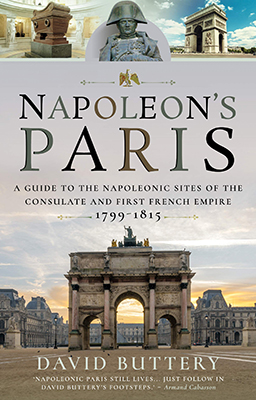Book
Review:
Napoleon's Paris
By David Buttery



Paris in the late 18th Century was far from beautiful. It was overcrowded and its more than 500,000 residents were forced to put up with unhealthy street conditions, open sewers and shameful slums.
Paris did not even have a safe water supply.
It needed love and attention and Napoleon Bonaparte took up the challenge.
While magnificent new buildings were planned, Napoleon first concentrated on the city’s practical needs.
In his latest book Napoleon’s Paris, David Buttery looks into why the Emperor of France took a tarnished city and started it along a journey to become a shining example of civilization.
In 1798 Napoleon said: “If I were master of France I would want to make Paris not only the most beautiful city that had ever existed, but also the most beautiful that could exist.”
Once he gained control of the country and its people he
made his moves and decided: “The four most important things for the city of Paris are: water from the River Ourcq, new markets in the Halles, abattoirs and wine houses.”
Flood defences along the Seine to protect the city from major inundations were also near the top of his list.
As was improving the road system – creating the Rue de Rivoli – and its new buildings complete with modern sewerage, together with more bridges across the Seine.
And if you enjoy being able to wander around any city in the world and get a good bead on where you are – thank Napoleon for introducing street name signs and numbering.
Napoleon’s Paris is an invaluable handbook that allows fans of the Napoleonic Era to not only explore key sites around The City of Light, but also appreciate their history.
The book starts with a 27-page biography of Bonaparte and then explores what he wanted for the French capital through 13 more pages. The latter are crucial to understanding just how much he wanted – and the massive amount of change he created.
Having wandered through the lovely streets of Paris and visited many of the sites mentioned in this book I would have benefited from having read this guide.
The main chapters are on the Musee Napoleon (otherwise known as the Palais du Louvre or more commonly the Louvre), the Arc de Triomphe, the Battle of Paris (the Allied invasion in 1814), Walks Along the Seine (Right and Left Banks), Heroes of the First French Empire (Pere Lachaise Cemetery), A Fitting Tribute Hotel des Invalides) , Napoleonic Sites Outside of Paris (Malmaison, Vincennes and Fontainebleau) and Exploring Paris, which is a general guide to the city.
The detail in each shows Buttery’s eye for detail and love of history.
My favourite was the section on how to find the graves of many of Napoleon’s marshals. They include Louis-Gabriel Suchet, Joachim Murat, Andre Massena, Louis-Nicholas Davout, Michel Ney and Emmanuel Grouchy.
When I was hunting for the tomb containing Jean Lannes’s heart in Montmartre it took me a very long time to track it down. Buttery’s guide to Pere Lachaise will have you finding them quickly so as to spend more time savouring the sites.
And I like Buttery’s writing style - which is very readable and informative.
His book not only brings back wonderful memories of Napoleonic exploration around central Paris, but gave us plenty of new things to discover on our next visit.
Napoleon’s Paris is a must-have for anyone considering a trip to the City of Light.
-
Richard Moore
8/10
Pen and Sword, ISBN 9781526749475.